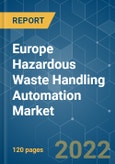The European hazardous waste handling automation market is expected to register a CAGR of 7.5% during the forecast period. With the outbreak of COVID-19, companies are offering innovative solutions to foster automation solutions in the waste management industry. The control of the COVID-19 pandemic and restrictions on business operations, travel, and the manufacturing sector had a considerable impact on waste management. Especially during the COVID-19 pandemic, waste management is crucial for health outcomes, thus, driving more demand for waste handling equipment.
Key Highlights
- The hazardous waste handling automation market is expected to grow significantly over the forecast period due to the stringent governmental and industrial regulations to maintain people's safety from hazardous waste.
- Furthermore, several non-government organizations (NGOs) and community-based organizations (CBOs) are stepping in to help hospitals and other healthcare facilities collect, recycle, and dispose of medical waste. Such initiatives are expected to boost further the adoption of automation solutions for waste management.
- Hazardous waste consists of the materials generated daily by people, power plants, and manufacturing companies. The use of such automation solutions for handling waste improves the process efficiency and reduces manual intervention reliability, as it can be dangerous to the human body. Hence, the concerns about the proper handling of these harmful substances can be eliminated. Such increasing safety concerns are expected to boost the demand for automation solutions in waste management in the region.
- Also, hazardous waste poses an enormous threat to public health. It has to be treated, recycled, and disposed of effectively to prevent environmental pollution. The growing awareness has brought the government's attention toward setting up rules that can help effectively tackle these wastes.
Key Market Trends
Growing Concerns About Waste Management are Expected to Drive the Demand
- The automation solutions also help in controlling the expenditure toward healthcare treatment caused by the after-effects of these hazardous wastes on the population. The growth in awareness and the changing environmental conditions are expected to drive the global hazardous waste handling automation market.
- The manufacturing industry is one of the significant segments that produce waste globally. A large portion of these wastes is hazardous due to the presence of chemical substances. Furthermore, waste products from the manufacturing industries, such as paints, oils, batteries, strong acids and bases, reactive substances, and other ignitable wastes, should be disposed of with special care. The improper disposal of these wastes impacts the environment to a great extent, and ultimately, human beings. This aforementioned concern is a significant factor driving the market ahead. Therefore, the increasing amount of waste from the production and manufacturing sector is driving the market's growth.
- In order to avoid the direct contact of humans with hazardous waste, the need for automation increased drastically. By deploying various automation solutions, the concerns of proper handling can be reduced, and process efficacy can be improved.
- A crucial role is performed by trash segregation at the source and the deployment of specialized waste processing facilities to separate recyclable materials. Engineered landfill sites and investment in waste-to-energy facilities are required to dispose of residual waste after the exploitation of material resources. The possibility of generating energy from landfills via methane extraction or thermal treatment drives the demand for waste handling equipment.
Germany to Hold the Significant Share in the Market
- The public sanitation zone expands as metropolitan areas grow. Setting up trash transfer stations from small or medium-sized garbage trucks to larger trucks helps improve the efficiency of collection and transport operations in cities with expanding collection zones.
- Furthermore, the expense of garbage collection and transportation accounts for a large portion of waste disposal operations in the city, and improving collection and transportation efficiency reduces costs while maintaining or improving quality.
- The country is witnessing a series of new product launches and mergers and acquisitions in the market, as every vendor wants to utilize the opportunity. The major drivers behind the investments in the market are the continuous evolution and application of new technologies to unlock enormous volumes that were previously considered non-commercial.
- Furthermore, in August 2021, Orano, a French nuclear reprocessing company, announced a contract with German utilities EnBW, PreussenElektra, RWE, and Vattenfall to return all German nuclear waste at its La Hague reprocessing plant.
Competitive Landscape
The European hazardous waste handling automation market is moderately competitive in nature. Product launches, high expense on research and development, partnerships, and acquisitions are the prime growth strategies adopted by the companies in the region to sustain the intense competition.
- August 2021 - Merino Industry Ltd, a laminate producer, placed an order for several machines from Pallmann’s portfolio, where the order consists of three knife ring flakers, two double stream mills, and a re-chipper. The delivery of the Pallmann machines for the company is scheduled for March 2022.
Additional Benefits:
- The market estimate (ME) sheet in Excel format
- 3 months of analyst support
Table of Contents
Companies Mentioned (Partial List)
A selection of companies mentioned in this report includes, but is not limited to:
- PaR Systems Inc.
- Konecranes PLC
- DX Engineering
- Floatograph Technologies
- Pallmann
- Hosokawa Micron Powder Systems
- ACE Inc.
- Terex MHPS GmbH
- Hiab
- PENZ Crane
Methodology

LOADING...








